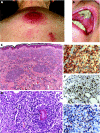CD56-positive haematological neoplasms of the skin: a multicentre study of the Cutaneous Lymphoma Project Group of the European Organisation for Research and Treatment of Cancer
- PMID: 17018683
- PMCID: PMC1972425
- DOI: 10.1136/jcp.2006.042135
CD56-positive haematological neoplasms of the skin: a multicentre study of the Cutaneous Lymphoma Project Group of the European Organisation for Research and Treatment of Cancer
Abstract
Background: Cutaneous lymphomas expressing CD56, a neural cell adhesion molecule, are characterised in most cases by a highly aggressive clinical course and a poor prognosis. However, prognostic subsets within the CD56+ group have been difficult to identify due to the lack of uniform clinicopathological and immunophenotypical criteria.
Methods: A multicentre study was conducted by the Cutaneous Lymphoma Task Force of the European Organisation for Research and Treatment of Cancer to define prognostic parameters and establish diagnostic and therapeutic guidelines for CD56+ haematological neoplasms presenting primarily in the skin.
Results: Four different subtypes of lymphoproliferations with CD56 expression were identified: (1) haematodermic neoplasm; (2) skin infiltration as the first manifestation of CD56+ acute myeloid leukaemia; (3) nasal-type extranodal natural killer/T-cell lymphoma; and (4) "classical" cases of cutaneous T-cell lymphoma (CTCL) with co-expression of the CD56 molecule. Patients in the first three groups had a poor outcome (93% died) with a median survival rate of 11 months (95% CI 2-72 months), whereas all patients with CD56+ CTCL were alive at the last follow-up.
Conclusion: Results show that CD56+ cutaneous lymphoproliferative disorders, with the exception of CD56+ CTCL have a very poor prognosis. It is therefore clinically important to separate CD56+ CTCL from the remaining CD56+ haematological disorders.
Conflict of interest statement
Competing interests: None declared.
References
-
- Griffin J D, Hercend T, Beveridgeet al Characterization of an antigen expressed by human natural killer cells. J Immunol 19831302947–2951. - PubMed
Publication types
MeSH terms
Substances
LinkOut - more resources
Full Text Sources
Medical
Research Materials





